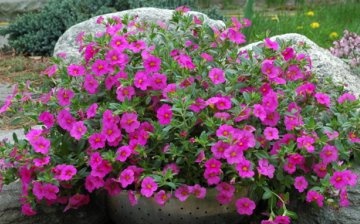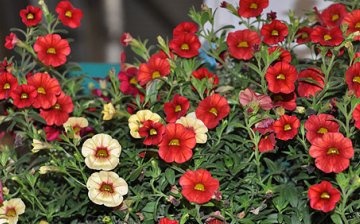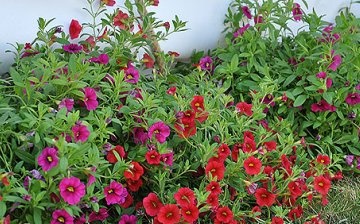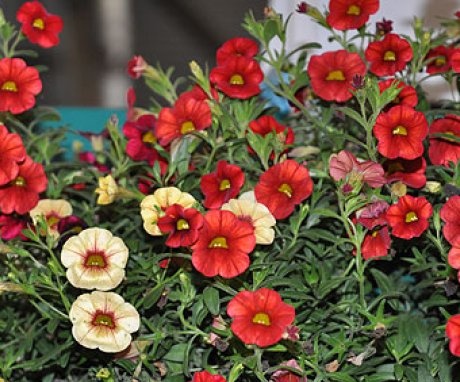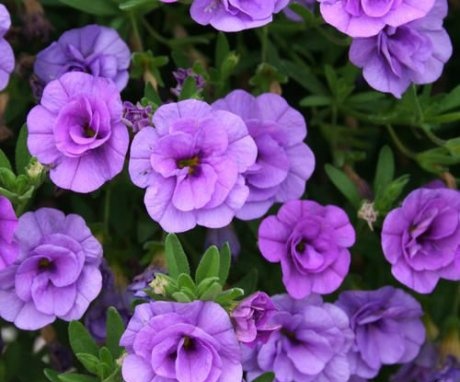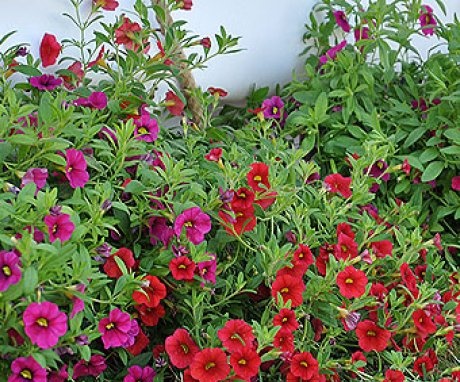Calibrachoa pictured - do not confuse it with petunia
Seeing the calibrachoa in the photo, you can confuse it with the petunia we are used to. Yes, their flowers are similar, and this is not strange, since initially the most decorative type of calibrachoa was derived from the genus Petunias. By changing the number of chromosomes, Japanese breeders have achieved a significant change in the appearance of petunias: calibrachoa have 18 chromosomes, while petunias have only 14.
Content:
Distinctive features of calibrachoa
The difference between calibrachoa and petunia becomes apparent upon close inspection of the plants. Calibrachoa stems in the photo look more lignified, more prone to branching, have ampelous growth form.
Calibrachoa lashes from hanging pots can hang by 1.5-2 meters!
The leaves of the calibrachoa are smaller and covered with a hard downy, like the stems. The flowers of both plants are similar in shape, but in calibrachoa they are smaller - only 3 cm in diameter, but there are not only much more of them than in Petunia, there are a huge number of them. Therefore, the most common type of calibrachoa is called Million Bells. There is another species called Superbells with double flowers of various colors.
The most popular are the following varieties of calibrachoa:
- Coral Pink - pink with coral-colored centers and veins;
- "Kalita white" (Calita White) - white with yellowish-light green centers;
- "Cherry Star" - dark pink with centers and pronounced streaks of yellow, which create a star shape;
- Apricot Punch - yellow with orange centers and veins;
- "Pink chiffon" (Pink shiffon) - light pink delicate color with a dark pink center and veins;
- "Grape Punch" (Grape Punch) - purple with a dark rich center and veins.
Double-flowered super bells are represented by such common types as:
- "Double Yellow" - bright yellow flowers;
- Double Pink - deep pink color;
- "Double Ruby" - ruby color.
Calibrachoa care secrets
In order for calibrachoa to please the eye with its lush flowering, you must adhere to the following recommendations:
- the soil can be any, but fertile, moisture-consuming and loose. It is better to fertilize it with compost or humus. Fresh manure for top dressing not suitable, as it makes plants more likely to be affected by fungal infections. Soils with high acidity should be optimized for planting calibrachoa by adding lime;
- for the successful cultivation of calibrachoa, a sunny place and sufficient heat are required. Being ampelous plants, they, planted in hanging pots, can be very affected by the wind. Therefore, they need to choose a place in the garden taking into account this factor;
- rain is very dangerous for calibrachoa. The flowers of this plant are very delicate, and the drops of rain, upon impact, quickly break the petals, which turns a well-groomed plant into a sloppy one in an instant;
- The volume and shape of the pot or container plays an important role in the cultivation of calibrachoa, as the flower roots grow in width. The optimal solution is to choose a low-volume 5-liter cookware;
- a large number of seedlings are planted in each pots or container at once - about 70 young plants per sq. m. For example, a pot with a top diameter of 30 cm will require up to 7 pieces of seedlings;
- during the summer, calibrachoa needs additional feeding, since abundant flowering requires a significant amount of nutrients. For these purposes, complex mineral fertilizers are used, which are easy to purchase in flower shops or specialized departments of supermarkets;
- calibrachoa likes frequent watering and spraying of leaves in dry hot weather (should be sprayed in the morning or evening);
- reproduction occurs by cuttings, which is another distinguishing feature of petunias feature of calibrachoa.
Reproduction of calibrachoa
In order for the plants to be preserved for the next year, they must be placed in a cool place with a temperature not higher than +12 degrees. They start grafting in February: the tops with 5-6 leaves are cut off, the lower ones are cut off, leaving only 2 upper leaves, and planted in the soil in boxes 1/4 of the length of the cuttings. The distance between the cuttings is left about 2 cm. The boxes are covered with glass and kept indoors at a temperature of at least +20 degrees.
The use of a growth regulator promotes faster rooting calibrachoa. With the appearance of new leaves, plants can be transplanted into containers for diving seedlings. After 30–40 days, the overgrown calibrachoa are transplanted into stationary containers: hanging baskets, boxes, and containers.
Calibrachoa is capable of decorating balconies, terraces, becoming a dominant feature in any garden composition with its exuberant bright flowering. Planters with plants of original color will soften even the most austere facade of the building and please the eye throughout the summer.



